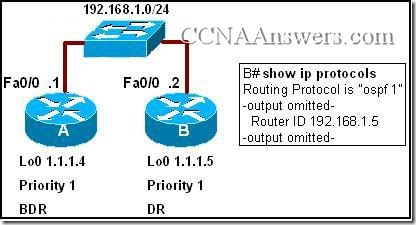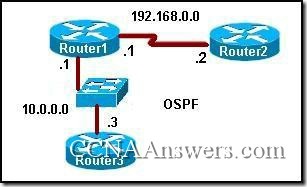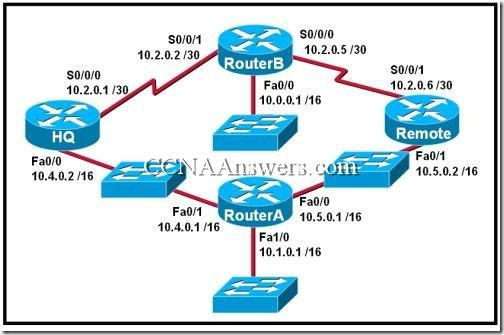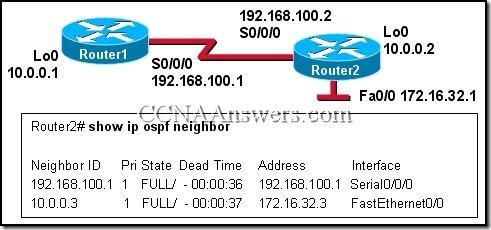The Candid Test On CCNA Chapter 11

With a CCNA certificate you will be able to have unlimited careers in the digital industry. With about ten hours a week of study you are able to pass the exam with a lot of ease. The candid test on CCNA Chapter 11 below is designed to jog your memory on what we learnt.
- 1.
Refer to the exhibit. All routers are running OSPF. What cost would JAX put in its routing table for the 10.0.0.0/24 network?
- A.
2
- B.
156
- C.
1564
- D.
1785
- E.
1787
Correct Answer
E. 1787Explanation
In OSPF, the cost metric is calculated based on the bandwidth of the interface. The higher the bandwidth, the lower the cost. Since the question does not provide any specific information about the bandwidth of the interface between JAX and the 10.0.0.0/24 network, we cannot determine the exact cost. However, we can conclude that JAX would put a cost of 1787 in its routing table for the 10.0.0.0/24 network.Rate this question:
-
- 2.
Refer to the exhibit. Router1 and Router2 are running OSPF. The show ip ospf neighbor command reveals no neighbors. What is a possible cause?
- A.
OSPF autonomous system IDs do not match.
- B.
OSPF process IDs do not match.
- C.
OSPF network types are identical.
- D.
OSPF hello or dead timers do not match.
Correct Answer
D. OSPF hello or dead timers do not match.Explanation
The possible cause for the show ip ospf neighbor command revealing no neighbors is that the OSPF hello or dead timers do not match. OSPF neighbors establish and maintain adjacency by exchanging hello packets at regular intervals. If the hello or dead timers are not configured to match on Router1 and Router2, they will not be able to establish a neighbor relationship and therefore the show ip ospf neighbor command will not display any neighbors.Rate this question:
-
- 3.
A fully converged five router OSPF network has been running successfully for several weeks. All configurations have been saved and no static routes are used. If one router looses power and reboots, what information will be in its routing table after the configuration file is loaded but before OSPF has converged?
- A.
All routes for the entire network will be present.
- B.
Directly connected networks that are operational will be in the routing table.
- C.
Because the SPF algorithm has not completed all calculations, no routes will be in the table.
- D.
A summary route for all previously learned routes will automatically appear in the routing table until all LSPs have been received by the router.
Correct Answer
B. Directly connected networks that are operational will be in the routing table.Explanation
After the router loses power and reboots, the configuration file is loaded but OSPF has not yet converged. This means that the SPF algorithm has not completed all calculations. As a result, no routes will be present in the routing table except for the directly connected networks that are operational. These directly connected networks will be the only ones that the router has immediate knowledge of, while it waits for OSPF to converge and update the routing table with all the routes for the entire network.Rate this question:
-
- 4.
Refer to the exhibit. What configuration statements would give the results that are shown in the output of the show ip protocols command?
- A.
B(config)# int fa0/0 B(config-if)# router-id 192.168.1.5
- B.
B(config)# int lo0 B(config-if)# ip address 192.168.1.5
- C.
B(config)# router ospf 1 B(config-router)# router-id 192.168.1.5
- D.
B (config)# router ospf 1 B(config-router)# ip address 192.168.1.5
Correct Answer
C. B(config)# router ospf 1 B(config-router)# router-id 192.168.1.5Explanation
The configuration statements B(config)# router ospf 1 and B(config-router)# router-id 192.168.1.5 would give the results shown in the output of the show ip protocols command. These statements configure OSPF with process ID 1 and set the router ID to 192.168.1.5. The router ID is used to uniquely identify the router within the OSPF domain.Rate this question:
-
- 5.
- A.
A FULL adjacency is formed.
- B.
A 2WAY adjacency is formed.
- C.
Router2 will become the DR and Router1 will become the BDR.
- D.
Both routers will become DROTHERS.
Correct Answer
A. A FULL adjacency is formed. -
- 6.
What does OSPF use to calculate the cost to a destination network?
- A.
Bandwidth
- B.
Bandwidth and hop count
- C.
Bandwidth and reliability
- D.
Bandwidth, load, and reliablity
Correct Answer
A. BandwidthExplanation
OSPF uses bandwidth to calculate the cost to a destination network. The cost is determined based on the bandwidth of the links along the path to the destination. A higher bandwidth link will have a lower cost, indicating a faster and more efficient path. This allows OSPF to select the best path to a destination network based on the available bandwidth.Rate this question:
-
- 7.
Refer to the exhibit. The routers in the exhibit are using default OSPF configuration settings to advertise all attached networks. If all of the routers start at the same time, what will be the result of the DR and BDR elections for this single area OSPF network? (Choose three.)
- A.
HQ will be DR for 10.4.0.0/16.
- B.
Router A will be DR for 10.4.0.0/16.
- C.
HQ will be BDR for 10.4.0.0/16.
- D.
Router A will be DR for 10.5.0.0/16.
- E.
Remote will be DR for 10.5.0.0/16.
- F.
Remote will be BDR for 10.5.0.0/16.
Correct Answer(s)
B. Router A will be DR for 10.4.0.0/16.
C. HQ will be BDR for 10.4.0.0/16.
E. Remote will be DR for 10.5.0.0/16.Explanation
Router A will be elected as the Designated Router (DR) for the network 10.4.0.0/16. HQ will be elected as the Backup Designated Router (BDR) for the network 10.4.0.0/16. Remote will be elected as the DR for the network 10.5.0.0/16.Rate this question:
-
- 8.
What does OSPF use to reduce the number of exchanges of routing information in networks where large numbers of neighbors are present? (Choose two.)
- A.
Root router
- B.
Backup root router
- C.
Domain router
- D.
Backup domain router
- E.
Designated router
- F.
Backup designated router
Correct Answer(s)
E. Designated router
F. Backup designated routerExplanation
OSPF (Open Shortest Path First) uses designated routers to reduce the number of exchanges of routing information in networks with a large number of neighbors. The designated router is responsible for collecting and distributing routing information to all other routers within the network. By having a designated router, the other routers only need to exchange routing information with this designated router, rather than exchanging information with every other router in the network. This reduces the amount of routing information exchanges and helps to optimize network performance. The backup designated router is also utilized to provide redundancy in case the designated router fails.Rate this question:
-
- 9.
Refer to the exhibit. All routers have been configured with the interface priorities that are shown. All routers were restarted simultaneously. The results of the DR/BDR election are shown. What can be concluded about this network?
- A.
Router C cannot win a DR election under any circumstances.
- B.
If the link for interface 192.168.1.4 goes down, router B will become the new DR.
- C.
The highest router ID was most likely determined via an OSPF router-id statement or statements.
- D.
If a new router is added with a higher router ID than router D, it will become the DR.
Correct Answer
C. The highest router ID was most likely determined via an OSPF router-id statement or statements.Explanation
The fact that the highest router ID was most likely determined via an OSPF router-id statement or statements can be concluded from the given information. This is because the router with the highest router ID, which is router D, has been elected as the DR. This indicates that the router ID played a significant role in the DR/BDR election process.Rate this question:
-
- 10.
Refer to the exhibit. Router A is correctly configured for OSPF. Which OSPF configuration statement or set of statements was entered for router B to generate the exhibited routing table?
- A.
B(config-router)# network 192.168.1.0 0.0.0.3 area 0
- B.
B(config-router)# network 10.16.1.0 0.0.0.224 area 0
- C.
B(config-router)# network 10.16.1.0 255.255.255.224 area 0
- D.
B(config-router)# network 192.168.1.0 255.255.255.255 area 0
- E.
B(config-router)# network 10.0.0.0 255.255.255.255 area 0
Correct Answer
A. B(config-router)# network 192.168.1.0 0.0.0.3 area 0Explanation
The correct answer is B(config-router)# network 192.168.1.0 0.0.0.3 area 0. This statement is used to enable OSPF on the interface connected to the 192.168.1.0 network with a wildcard mask of 0.0.0.3, which means that only the first two bits of the fourth octet will be considered for OSPF. This will include the IP addresses 192.168.1.0, 192.168.1.1, 192.168.1.2, and 192.168.1.3 in the OSPF routing process.Rate this question:
-
- 11.
Refer to the exhibit. Assuming that the routers have default interface OSPF priorities and no configured loopback interfaces, what two roles will router B play on each network segment? (Choose two.)
- A.
DR for network 192.168.1.200
- B.
BDR for network 192.168.1.200
- C.
DROTHER on 192.168.1.200
- D.
DR for network 192.168.1.204
- E.
BDR for network 192.168.1.204
- F.
DROTHER on network 192.168.1.204
Correct Answer(s)
A. DR for network 192.168.1.200
E. BDR for network 192.168.1.204Explanation
Router B will play the role of DR (Designated Router) for network 192.168.1.200 and the role of BDR (Backup Designated Router) for network 192.168.1.204.Rate this question:
-
- 12.
Refer to the exhibit. Routers A, B, C, and D are all running OSPF with default router IDs and OSPF interface priorities. Loopback interfaces are not configured and all interfaces are operational. Router D is the DR and router C is the BDR. What happens immediately after the following commands are entered on router A? A(config)# interface fa0/0 A(config-if)# ip ospf priority 255
- A.
A will become the DR. D will become the BDR.
- B.
A will become the DR. C will remain the BDR.
- C.
D will remain the DR. A will become the BDR.
- D.
D will remain the DR. C will remain the BDR.
Correct Answer
D. D will remain the DR. C will remain the BDR.Explanation
The command "ip ospf priority 255" sets the OSPF priority of the interface fa0/0 on router A to the highest possible value. However, the priority of a router interface only affects the election of the DR and BDR if there is a tie in the OSPF router ID. Since the question states that all routers are running OSPF with default router IDs, the router with the highest router ID will always be elected as the DR, and the router with the second highest router ID will be elected as the BDR. Therefore, even with the highest priority on interface fa0/0, router A will not become the DR or the BDR. Router D will remain the DR and router C will remain the BDR.Rate this question:
-
- 13.
What range of networks will be advertised in the OSPF updates by the command Router1(config-router)# network 192.168.0.0 0.0.15.255 area 100?
- A.
192.168.0.0/24 through 192.168.0.15/24
- B.
192.168.0.0/24 through 192.168.15.0/24
- C.
192.168.15.0/24 through 192.168.31.0/24
- D.
192.168.15.0/24 through 192.168.255.0/24
- E.
192.168.16.0/24 through 192.168.255.0/24
Correct Answer
B. 192.168.0.0/24 through 192.168.15.0/24Explanation
The command "network 192.168.0.0 0.0.15.255" in OSPF configuration specifies that the network 192.168.0.0/24 through 192.168.15.0/24 should be advertised in OSPF updates. The wildcard mask 0.0.15.255 indicates that the first 20 bits of the network address should match exactly, while the last 12 bits can be any value. Therefore, the range of networks advertised will include all subnets from 192.168.0.0/24 to 192.168.15.0/24.Rate this question:
-
- 14.
Refer to the exhibit. RouterA, RouterB, and RouterC in the diagram are running OSPF on their Ethernet interfaces. Router D was just added to the network. Routers are configured with the loopback interfaces (Lo 0) that are shown in the exhibit. What happens to the OSPF DR/BDR after RouterD is added to the network?
- A.
RouterB takes over as DR and RouterD becomes the BDR.
- B.
RouterD becomes the BDR and RouterA remains the DR.
- C.
RouterD becomes the DR and RouterA becomes the BDR.
- D.
RouterC acts as the DR until the election process is complete.
- E.
RouterD becomes the DR and RouterB remains the BDR.
- F.
There is no change in the DR or BDR until either current DR or BDR goes down.
Correct Answer
F. There is no change in the DR or BDR until either current DR or BDR goes down.Explanation
When RouterD is added to the network, there is no immediate change in the OSPF DR/BDR (Designated Router/Backup Designated Router) election process. The election for DR/BDR only occurs when there is a change in the network or when the current DR/BDR goes down. Therefore, until either the current DR or BDR goes down, there will be no change in the DR or BDR.Rate this question:
-
- 15.
Refer to the exhibit. How many OSPF adjacencies must be formed to build the complete topology if a DR or BDR were not elected in this OSPF network?
- A.
4
- B.
5
- C.
6
- D.
7
- E.
10
Correct Answer
C. 6Explanation
In an OSPF network, each router forms an adjacency with every other router in the network. Without a designated router (DR) or backup designated router (BDR) elected, each router will still form an adjacency with every other router. In the given exhibit, there are a total of 7 routers. To build the complete topology, each router must form an adjacency with the other 6 routers in the network. Therefore, the correct answer is 6.Rate this question:
-
- 16.
What is the default administrative distance for OSPF?
- A.
90
- B.
100
- C.
110
- D.
115
- E.
120
Correct Answer
C. 110Explanation
The default administrative distance for OSPF is 110. Administrative distance is a metric used by routers to determine the best path for forwarding network traffic. OSPF is a routing protocol that uses this metric to determine the best path within an autonomous system (AS). A lower administrative distance indicates a more preferred route. In the case of OSPF, a default administrative distance of 110 means that OSPF routes are preferred over routes from other routing protocols with higher administrative distances.Rate this question:
-
- 17.
Refer to the exhibit. Which command sequence on RouterB will redistribute a gateway of last resort to the other routers in OSPF area 0?
- A.
RouterB(config)# router ospf 10 RouterB(config-router)# gateway-of-last-resort 172.16.6.6 RouterB(config)# ip route 0.0.0.0 0.0.0.0 serial 0/0/0
- B.
RouterB(config)# ip route 0.0.0.0 0.0.0.0 172.16.6.6 RouterB(config)# router ospf 10 RouterB(config-router)# default-information originate
- C.
RouterB(config)# router ospf 10 RouterB(config-router)# default-network 172.16.6.6 0.0.0.3 area 0 RouterB(config)# ip route 0.0.0.0 0.0.0.0 172.16.6.6
- D.
RouterB(config)# ip default-route 0.0.0.0 0.0.0.0 172.16.6.6 RouterB(config)# router ospf 10 RouterB(config-router)# redistribute ip default-route
Correct Answer
B. RouterB(config)# ip route 0.0.0.0 0.0.0.0 172.16.6.6 RouterB(config)# router ospf 10 RouterB(config-router)# default-information originateExplanation
The correct answer is RouterB(config)# ip route 0.0.0.0 0.0.0.0 172.16.6.6 and RouterB(config)# router ospf 10 RouterB(config-router)# default-information originate. This command sequence configures RouterB to redistribute the default route (gateway of last resort) into OSPF area 0. The first command sets up the default route with the next hop IP address of 172.16.6.6. The second command enables RouterB to advertise this default route to other routers in OSPF area 0. By redistributing the default route, other routers in the OSPF network will be aware of the gateway of last resort and can use it to reach destinations outside of the OSPF domain.Rate this question:
-
- 18.
Which two statements describe the use of OSPF DR/BDR elections? (Choose two.)
- A.
Elections are always optional.
- B.
Elections are required in all WAN networks.
- C.
Elections are required in point-to-point networks.
- D.
Elections are required in broadcast multiaccess networks.
- E.
Elections are sometimes required in NBMA networks.
Correct Answer(s)
D. Elections are required in broadcast multiaccess networks.
E. Elections are sometimes required in NBMA networks.Explanation
OSPF DR/BDR elections are used in broadcast multiaccess networks to select a designated router (DR) and a backup designated router (BDR) to reduce the amount of OSPF traffic and simplify the network. In these networks, all routers are connected to a common network segment, and the DR and BDR are responsible for exchanging OSPF information with other routers on behalf of the entire network. This ensures that only the DR and BDR need to maintain a full OSPF database, reducing the amount of OSPF traffic and processing power required by other routers. In NBMA networks, such as Frame Relay or X.25, elections are sometimes required if the network does not support multicast communication, and a designated router is needed to represent the network.Rate this question:
-
- 19.
Refer to the exhibit. What does the “2″ stand for in the router ospf 2 statement?
- A.
The number 2 is the autonomous system number.
- B.
The number 2 indicates the number of networks advertised by OSPF.
- C.
The number 2 indicates the number of networks advertised by OSPF.
- D.
The number 2 indicates the priority of the OSPF process on this router.
Correct Answer
C. The number 2 indicates the number of networks advertised by OSPF.Explanation
The number 2 indicates the number of networks advertised by OSPF.Rate this question:
-
- 20.
Refer to the exhibit. The network administrator wants to set the router ID of Router1 to 192.168.100.1. What steps can the administrator take to accomplish this?
- A.
Shut down the loop back interface
- B.
Use the OSPF router-id 192.168.100.1 command
- C.
Use the clear ip ospf process command
- D.
Nothing, the router-id of Router1 is already 192.168.100.1
Correct Answer
D. Nothing, the router-id of Router1 is already 192.168.100.1 -
- 21.
Refer to the exhibit. What must be received between neighbors to prevent the dead time that is shown in the exhibit from reaching zero?
- A.
Any traffic through the router interfaces
- B.
Routing database updates
- C.
Hello packets
- D.
BPDU packets
Correct Answer
C. Hello packetsExplanation
To prevent the dead time from reaching zero, hello packets must be received between neighbors. Hello packets are used by routing protocols to establish and maintain neighbor relationships. By exchanging hello packets, routers can periodically check the status and availability of their neighboring routers. This helps to ensure that the routers are still connected and functioning properly. If hello packets are not received within a certain time frame, the dead time will reach zero, indicating that the neighbor is no longer reachable.Rate this question:
-
- 22.
Refer to the exhibit. What does the “O*E2″ from the “O*E2 0.0.0.0/0 [110/1] via 192.168.1.1, 00:05:34, Serial0/0″ line represent?
- A.
An internal type 2 OSPF route.
- B.
An external OSPF route at least two hops away.
- C.
An external OSPF route from two different sources.
- D.
An external OSPF route that will not increment in cost.
- E.
A default route.
- F.
The route was distributed into OSPF from a type 2 router.
Correct Answer
D. An external OSPF route that will not increment in cost.Explanation
The "O*E2" in the "O*E2 0.0.0.0/0 [110/1] via 192.168.1.1, 00:05:34, Serial0/0" line represents an external OSPF route that will not increment in cost.Rate this question:
-
- 23.
Refer to the exhibit. Which network command or set of commands will cause OSPF to be enabled for any R1 interface connected to the exhibited subnets?
- A.
R1(config-router)# network 10.0.0.0 0.0.0.0 area 0
- B.
R1(config-router)# network 10.1.0.0 0.0.0.255 area 0 R1(config-router)# network 10.1.1.0 0.0.0.255 area 0 R1(config-router)# network 10.1.2.4 0.0.0.3 area 0
- C.
R1(config-router)# network 10.1.0.0 0.0.0.255 area 0 R1(config-router)# network 10.2.0.0 0.0.0.255 area 0
- D.
R1(config-router)# network 10.0.0.0 0.0.255.255 area 0
Correct Answer
B. R1(config-router)# network 10.1.0.0 0.0.0.255 area 0 R1(config-router)# network 10.1.1.0 0.0.0.255 area 0 R1(config-router)# network 10.1.2.4 0.0.0.3 area 0Explanation
The correct answer is a combination of three network commands. The first command "network 10.1.0.0 0.0.0.255 area 0" enables OSPF for any interface on R1 that falls within the range of 10.1.0.0 to 10.1.0.255. The second command "network 10.1.1.0 0.0.0.255 area 0" enables OSPF for any interface on R1 that falls within the range of 10.1.1.0 to 10.1.1.255. The third command "network 10.1.2.4 0.0.0.3 area 0" enables OSPF for any interface on R1 that falls within the range of 10.1.2.4 to 10.1.2.7. Together, these commands ensure that OSPF is enabled for all interfaces connected to the exhibited subnets.Rate this question:
-
- 24.
Refer to the exhibit. What is the cost of the route to the 10.0.0.0 network?
- A.
2
- B.
110
- C.
1786
- D.
1.544
Correct Answer
C. 1786Explanation
The cost of the route to the 10.0.0.0 network is 1786.Rate this question:
-
- 25.
What three parameters must be indentical between OSPF routers in order to form an adjacency? (Choose three.)
- A.
Area id
- B.
K-values
- C.
Metric value
- D.
Hello interval
- E.
Network type
- F.
Interface type
Correct Answer(s)
A. Area id
D. Hello interval
E. Network typeExplanation
In order for OSPF routers to form an adjacency, three parameters must be identical: area id, hello interval, and network type. The area id is used to group routers into OSPF areas, and routers must be in the same area to form an adjacency. The hello interval is the time interval at which OSPF routers send hello packets to discover and maintain neighbor relationships. The network type defines how OSPF operates on a particular network interface. These three parameters must match between routers to establish OSPF adjacency.Rate this question:
-
Quiz Review Timeline +
Our quizzes are rigorously reviewed, monitored and continuously updated by our expert board to maintain accuracy, relevance, and timeliness.
-
Current Version
-
Mar 17, 2023Quiz Edited by
ProProfs Editorial Team -
Dec 20, 2011Quiz Created by
Ramon1988
 Back to top
Back to top

















![Refer to the exhibit. What does the “O*E2″ from the “O*E2 0.0.0.0/0 [110/1] via 192.168.1.1, 00:05:34, Serial0/0″ line represent?
Refer to the exhibit. What does the “O*E2″ from the “O*E2 0.0.0.0/0 [110/1] via 192.168.1.1, 00:05:34, Serial0/0″ line represent? - ProProfs](https://ccnaanswers.com/wp-content/uploads/CCNA2Chapter11V4.0Answers15_thumb.jpg)

